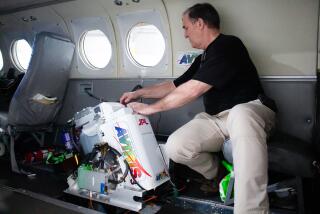The Lewis and Clark of Mars
- Share via
THE ruddy surface of the alien world unraveled before Ken Edgett’s eyes in noodle-like strips.
Each image from the camera aboard the Mars Global Surveyor covered a 2-mile-wide swath of dunes, rock valleys and jagged ribbons of carbon dioxide ice. Twelve orbits a day, for almost a decade. A total of 243,926 pictures of the Martian wasteland.
Edgett, a bushy-haired, 6-foot-2 scientist, stared himself half-blind as he scanned the pictures from his office in an industrial park outside San Diego. His companion through the years of surveying the planet was Mike Malin, the designer of the spacecraft camera and the president of Malin Space Science Systems Inc.
Together, they have studied more Martian craters, rock fields and mountains than any other earthling.
You might call them the Lewis and Clark of Mars.
Just as the early American adventurers explored the strange world west of the Mississippi River, Malin and Edgett have taken a journey of exploration across Mars. Instead of tramping through forests and valleys, they hitched a ride on a spacecraft.
Edgett has come to know Mars so well that you can show him a picture of a spot on the Red Planet and he can give you a good idea of where it is.
The two men are an unusual pair. Edgett, 41, gregarious and something of a cutup who loves slapstick movies, once ate a pig’s foot in a futile attempt to win tickets to a Pink Floyd concert. On a children’s TV show in Phoenix, he was “Ken the Science Guy.”
Malin, 57, smaller and more reticent, is a MacArthur Foundation “genius” award winner and a former university professor.
“Collectively, they do some of the most meticulous science that I’ve seen,” said Robert Pappalardo, a planetary expert at the Jet Propulsion Laboratory in La Canada Flintridge.
Through the laborious process of studying Mars meter by meter, they have changed the scientific world’s perception of the dusty planet.
It is no longer a dead rock. Edgett and Malin have detailed a rich and complex world that may include the existence of some form of life.
“Besides Earth, Mars is once again the most exciting place in the solar system,” said Caltech astronomer Bruce Murray.
Malin, true to form, is unimpressed with the implications of his own work.
“I don’t actually think there is life on Mars,” he said.
--
A much earlier generation imagined Mars as a world with alien boatmen plying an intricate network of canals. American astronomer Percival Lowell began intently surveying the planet near the end of the 19th century. He imagined a dying civilization forced to build canals to survive the desiccation around them.
It was not until the mid-1960s, when a string of robotic missions to Mars began, that science began to catch up with fantasy.
Mariner 4 flew past Mars at close range in 1965. Viking 1 and 2 dropped onto the surface of the planet in 1976 to conduct a search for life.
“Cold, dry, rocky surface is what we saw around us,” Dan McCleese, the chief scientist at JPL, said recently. “Viking led us to close the doors to further exploration. Nobody wanted to hear the ‘life’ word associated with Mars.”
Mars was “self-sterilizing,” scientists said. Solar radiation and the extreme dryness of the place made it a barren world. If there was ever life, it died out billions of years ago.
The search for interesting places fixed on Europa, the enigmatic ice-covered moon of Jupiter, and Titan, Saturn’s smog-choked moon.
But for Edgett, Mars has been a fascinating place since he was a child growing up in Rochester, N.Y. He remembers looking out on the first snow of winter when he was 10 and wondering whether Mars was like that.
Malin had been exploring the cosmos since he was a graduate student in the 1970s at Caltech, studying planetary sciences and geology. Later, at JPL and Arizona State University, where he was a geology professor, he embraced the budding field of photogeology -- the study of geology through high-resolution imagery.
In 1990, Malin tossed away his promising academic career to start a company building cameras for NASA.
“I don’t work well in large institutions,” he explained. “I’m kind of a maverick.”
His gamble nearly failed when the first camera his team built was lost with the Mars Observer spacecraft in 1993. He was lucky he had enough parts left over for a second camera when the Mars Global Surveyor mission came around four years later.
Not everyone was excited about the $247-million mission.
But as engineers prepared the new camera for launch aboard Global Surveyor, Malin made a crucial demand: It must resolve images as small as a meter, or 3.3 feet. No camera had ever reached that level of detail from orbit.
In the end, their camera and its 14-inch telescope, weighing just over 40 pounds, were safely on board when the spacecraft took off Nov. 7, 1996, on a mission to map the surface, measure the atmosphere and check for a magnetic field.
--
IT took nearly a year for Global Surveyor to reach Mars.
Malin and Edgett, who had recently joined the company after getting a doctorate in geology from Arizona State University, anxiously waited through the journey.
Just weeks before its arrival, another craft, Mars Pathfinder, dropped a little robot onto the surface.
The plucky Sojourner rover was a hit with the public, rolling around its landing site and taking pictures of rocks. But it too found a barren world.
Global Surveyor finally eased into its 234-mile-high polar orbit. In September 1997, the first close-up images began appearing on Malin’s computer screen.
“This is a completely different Mars than anyone was thinking about,” Caltech’s Murray said after Malin showed him some of the early pictures.
The first big surprise was the great quantity of layered rocks covering the planet, especially in Valles Marineris, the 6-mile-deep cavity that rips 3,000 miles across the Martian surface.
“Earth didn’t preserve those rock formations,” Edgett said, referring to the layered rocks. “Mars is the only terrestrial planet with an atmosphere that has preserved a record of its earliest history.”
The layers told a complex tale that scientists are still trying to explain.
Consider Henry Crater. A quarter of it is filled with rock.
“What that tells us is Henry was once filled to the brim with sedimentary rock,” Malin said. “We do not know where the material came from. You can speculate there was a lake there that filled with sediment. But after that, something broke down three-quarters of it and took it out of the crater.... Where did it go? There are hundreds, if not thousands, of craters with the same story.”
On any given day, Edgett reviewed 50 to 300 pictures. It would sometimes take a couple of hours to get through them. Other times, he labored deep into the night, trying to understand what was in front of him.
Most days, Malin stopped by Edgett’s office for a chat about what they’d just seen.
“Often out of those discussions came new discoveries,” Edgett said. “I’m sure Lewis and Clark did that, too.”
Edgett was fascinated by textures in the landscape. Around Alba Patera, a volcano in the north, the surface had a “bubbly” appearance. The equatorial region was sandy. The middle latitudes were scabby. In Noachis Terra in the south, there were huge dune fields. But these dunes were different from Earth’s. Channels cut across their surfaces.
Edgett took notes on what he saw each day, compiling a diary of his journeys.
“View of north polar cap at the start of summer,” he wrote one day. “Pretty cool image pair.”
“Light-toned outcrops, ridgey surfaces,” he added.
“Cool polygon patterns on or under north polar frost; lots of nifty polar layers.”
His work schedule was relentless. Lunch was Subway. Dinner at Carl’s Jr.
“You couldn’t get me to go home. I would spend 12 hours a day, six or seven days a week” studying the pictures, he said.
Friends often asked him what Mars was like. Edgett had trouble answering.
He was one of the few to witness the beauty of Hellas Basin during the winter when the haze lifts and the atmosphere is crystal clear. He had wandered through the heavily cratered landscape of Arabia Terra and searched the hazy southern rim of Valles Marineris.
How could he describe the bizarre, Swiss-cheese pattern of the south polar icecap?
A colleague warned him that observing another planet was a marathon, not a sprint, but Edgett ignored him.
He wasn’t sure what he was looking for, but his goal was clear -- to find some sign of past or present water flow.
Liquid water is crucial to any hopes of finding life on another planet. Basic biological processes, the ones we know about, require a liquid environment.
It took two years.
In 1999, Edgett scanned some images in which he spotted narrow gullies along a canyon wall. They were at most a few thousand years old.
It could be an indication of water erosion. He decided to focus in on the gullies whenever Global Surveyor passed overhead to look for any changes.
“It was always kind of a joke,” Edgett said. “Yeah, right, we’re going to see change.”
Then in 2005, he saw something unusual. Shiny, white, ice-like flows appeared in two of the gullies.
“Oh, that’s different,” Edgett said to himself. The flows were near the limits of the camera’s resolving powers.
His diary entry recorded his excitement: “recently active gully??
He and Malin accounted for the time of day, the strength of the sun, every possible counter-explanation they could find.
“Then we were left with, ‘Geez, maybe they are water flows,’ ” Edgett said.
They held onto their discovery for a year while they tested the theory and wrote it up for publication in the prestigious journal Science.
Edgett’s best theory is that some underground heat source is melting subsurface ice. The pressure from this underground reservoir builds up behind a plug of ice on the surface until the cap pops off. Water bursts onto the surface and flows downhill before flash-freezing.
In December 2006, Edgett and Malin announced their discovery, which was quickly hailed as one of the greatest solar system finds in decades.
“Now thinking about life on Mars isn’t a search for past life,” said Pappalardo of JPL.
--
STILL concerned that the whitish flow could be a trick of lighting, NASA has in recent months trained its high-resolution HiRise camera on the Mars Reconnaissance Orbiter on the gullies. The orbiter arrived on Mars last year, and its HiRise camera can focus in on objects 1 foot across.
Rich Zurek, chief Mars scientist at JPL, said the new results supported the theory that water still flowed on the planet.
Malin is responsible for two other cameras on the orbiter, but not HiRise. His company also has three cameras on the Mars Science Laboratory, a jumbo rover scheduled for launch in 2009.
As for the Global Surveyor, just a few weeks before Edgett and Malin announced their find, the probe fell inexplicably silent. NASA officially declared the spacecraft dead in January, the victim of a faulty software command from ground controllers.
Edgett said goodbye to the Global Surveyor with mixed emotions. There were days when he was in the thick of exploration that it seemed too much. His relationships outside work suffered; he didn’t eat or sleep well.
But after journeying so many millions of miles, his life has become entwined with the planet.
“Mars is still this magical place to me,” he said.
--






